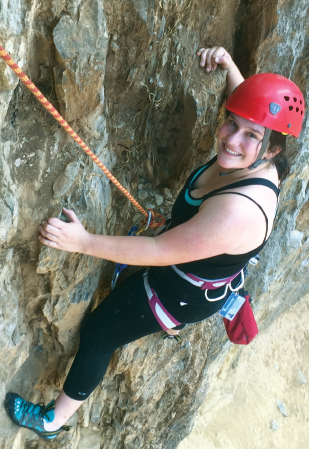Cathedral Peak thrilled us. We ascended 650 feet up the granite gem in Yosemite’s Tuolumne Meadows as the godly views improved by the minute. My first big rock climb has always stuck with me, including the last 50 feet where I got stuck.
My partner already reached the summit and I had to follow up a vertical crack in the rock. How to do that, I had no clue. There were no handholds or footholds like I had used before. Finally, I realized I had to step into the crack, which looked painful. So it was, but I did it anyway.
At the summit, an even grander view of the mountainous horizon rewarded my buddy and me. The challenges we overcame to see it made the victory especially sweet. That joyful moment made me a lifelong climber.
At least that’s the plan. Though I recently turned 50, I still enjoy outdoor pursuits, and I’m sharing 50 lessons I learned along the way. This column, the third of five, focuses on rock climbing.

2. Use indoor gyms to climb more and better. Nothing beats the beauty and enjoyment of climbing outdoors in places like Yosemite and Joshua Tree, but indoor gyms allow year-round and nighttime activity. Those of us with jobs appreciate the obvious benefits of this. In addition, gyms offer beginner classes and potential partners, including those with experience and gear which novices lack. So even if outdoor climbing fills your dreams, indoor climbing can help you achieve them. This depends on improved pandemic conditions, of course.
3. Pick a good partner. I usually climb with people I know well and trust, like friends or relatives. But it’s also good to climb with new people who can help you improve and discover new destinations. When I climbed the East Buttress of El Capitan (the easiest route on The Captain but a highlight climb for me), I benefited greatly from pairing up with a partner I met in Camp 4. I’ve had only good experiences when I’ve “dated” partners I met online.
4. “Five fun” is the best ability level. Climbing doesn’t have to be overly difficult to enjoy. I got started in Yosemite on moderate classics like Snake Dike, Nutcracker and Bishop’s Terrace, which fall between 5.6 and 5.8 in difficulty. I’ve achieved 5.10 on occasion, but I still enjoy moderate climbs the most, like The Eye and Double Cross in Joshua Tree and Corrugation Corner in Lovers Leap. Let Alex Honnold handle the cutting edge. No one has to prove anything to have a good time on the rock.
5. For those who don’t climb every day, don’t fret. General fitness will help you enjoy climbing when you can go. Running, cycling and other forms of aerobic exercise will keep you trim, which definitely helps. Upper body muscle helps too, of course. Pull ups are the simplest way to improve your ability.

7. If you think climbing delivers an adrenaline rush, try leading. That means taking the sharp end of the rope, as we say, and climbing above established protection, placing gear as you go. A leader assumes far greater risk of a significant fall and more responsibility for the success of the climb than the follower or second climber. Not everyone is suited for this, and one should follow many outdoor climbs first. But when you’re ready, leading a challenging route successfully can make you feel like a climbing rock star. If you feel motivated to try, then do your homework. Take a class, read a book or learn from an experienced partner about placing protection and building anchors.
8. Buy good gear, even though it’s expensive. Cams, which are reusable spring-loaded protection devices, cost up to $100 each and a leader might need a dozen of them or more to protect a single pitch. They are worth every cent when you’re run out high above your anchor and need to jam one into a crack quickly. Don’t cheap out on the rope, either. Get one 60 meters long, not 50 meters, as many climbs need the extra length between anchors.
9. If you lead and protect a climb well, then accept falling as part of the sport. To improve, a climber needs to push limits, and that means risking a fall. A climber on a top rope (in a gym, for example) should have nothing to fear. Lead climbers must accept greater risk, but should still fall harmlessly if they prepare and react correctly. This is an area where I’ve got mountain-sized room to improve, as I average about one leader fall every five years. In contrast, Tommy Caldwell fell hundreds of times on his six-year quest to climb the Dawn Wall of El Capitan. Better to split these two extremes.

Cathedral Peak keeps calling me back. Following my 50th birthday, I teamed up with my cousin to climb it for the seventh time. After the pandemic restricted the park all summer, we enjoyed a glorious autumn day.
When I reached the granite crack that had stumped me 26 years earlier, this time I knew how to place my hands and feet to climb it. But I also saw a ramp that allowed me to avoid the obstacle entirely! Then we climbed nearby Eichorn Pinnacle (5.4) as a bonus.
I’m looking forward to many more years on the rocks, and every time I see Cathedral Peak, I’m grateful to the majestic mountain for teaching me how to climb and how good climbing feels.





